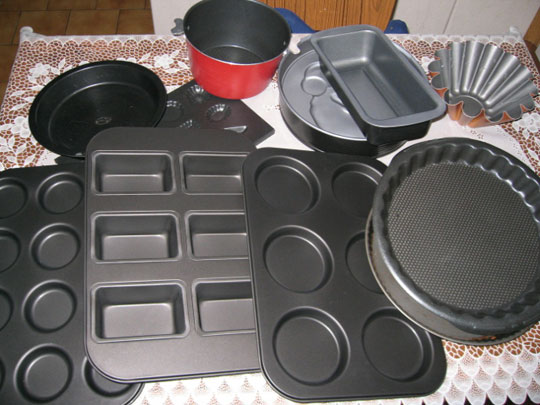Currently, many cooking tools on the market are coated with a non-stick coating. Actually, it is a heat-resistant polymer. After a period of use, they peel and can be harmful to health .

Walking around a shopping center and street selling household goods such as Hue Street, Hang Chao Street, Dong Xuan Market (Hanoi), we can see, non-stick saucepans, pots and pans are popular items. .
All prices have non-stick products
Recently, the market also appeared pots and pans . coated with enamel like stone face, which people call stone pan, stone pot . When cooking, food does not stick, very easy to peel and still advertised as not needing oil, fat still fried food.
It is worth mentioning, not only that the available items have a non-stick coating, but also the service of reprocessing the non-stick coating for cookware has been peeled off. Service prices are quite attractive: medium-sized pots and pans are only VND 20,000-30,000, and larger sizes are from VND 45,000 to VND 50,000.
Mr. Nguyen Thanh Vinh, owner of the processing facility in Mai Dong, Hoang Mai, Hanoi, said that the anti-stick technology is now popular, without worrying about quality or health effects (!?). But when asked carefully about the method and materials, Mr. Vinh only spoke briefly: that is the secret of tradition.
Observe, the price and products of anti-stick home appliances are very diverse. It is also a non-stick pan, but if it is made by China, it is only from 70,000 to 100,000 VND / unit, but if the brand's brand name, it must be 300,000 - 500,000 VND.
It is essentially a heat-resistant polymer
Assoc.Prof.Dr Pham Gia Dien, Institute of Chemistry said that the chemical anti-sticking agent is a heat-resistant polymer. There are many different types of anti-stick depending on the price it is good or bad (in terms of both effects and health effects).

Many of the cooking tools on the market are coated with a non-stick layer, carefully selected before being purchased and used (Photo: Kim Anh).
Ass Fill said, the most popular and commonly mentioned is Teflon compound. Teflon is a common and relatively inexpensive but unstable material that will wear over time and is easily scratched when exposed to metal cookware. The most noticeable feature when using this adhesive is that after a while, the pot, pan or peeling surface, may stick to the food, revealing the metal layer below.
Regarding the question, whether anti-stick substances for poisoning, Associate Professor Trinh Le Hung, Department of Chemistry, University of Natural Sciences, Hanoi National University said, should not be immediately confirmed that this substance is toxic when home Manufacturing strictly follows the technological process of products and consumers using the right recommendations.
This was also agreed by Assoc. Prof. Pham Gia Dien. Associate Professor Dien said, the nature of the polymer is not toxic, but if it is affected by the heat is too high to cause fire, decomposition will produce toxic substances.
Meanwhile, many scientific documents also indicate that, if cooked at temperatures exceeding 300 degrees C, Teflon produces toxic substances such as perflurooctanoic acid (PFOA), Perfluoisobutylene, Carbonylcloride . - are toxic substances that cause chest, difficulty breathing They can also cause cancer and miscarriage. In addition, for adhesives to adhere to materials, manufacturers also use other combinations such as a combination of liquid and colorants. These substances are made from metal compounds such as chromium, titanium, iron, copper, lead, manganese, cobalt .
The color and adhesive nature will give different types and colors of each product. Stone pans, ice pans are also such a product. It is possible that the manufacturer has given more metal compounds to form the same shape as grindstone.
Dr Quyen stressed that if there is no strict production process, it is easy to stop being infected with food and accumulating in the body.
 Green tea cleans teeth better than mouthwash?
Green tea cleans teeth better than mouthwash? Death kiss: This is why you should not let anyone kiss your baby's lips
Death kiss: This is why you should not let anyone kiss your baby's lips What is salmonellosis?
What is salmonellosis? Caution should be exercised when using aloe vera through eating and drinking
Caution should be exercised when using aloe vera through eating and drinking